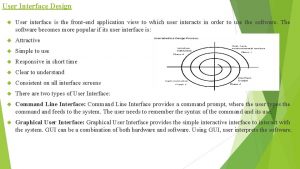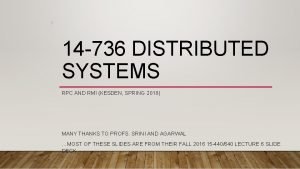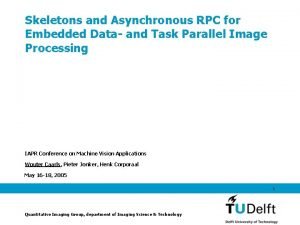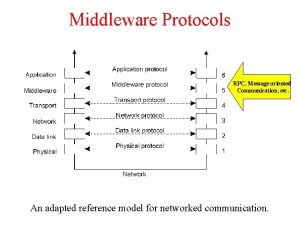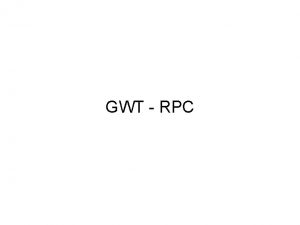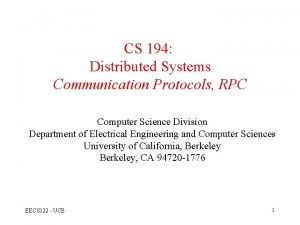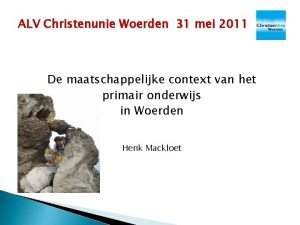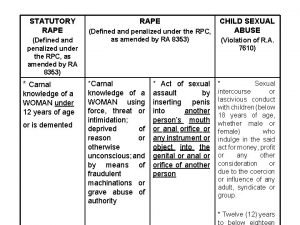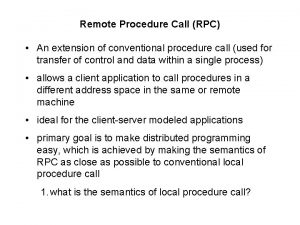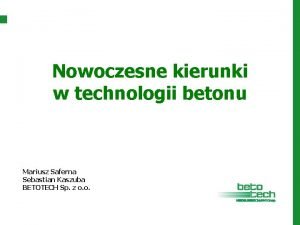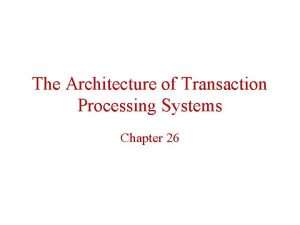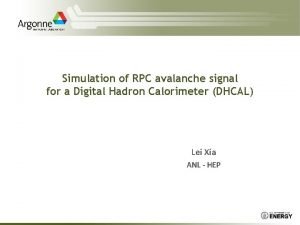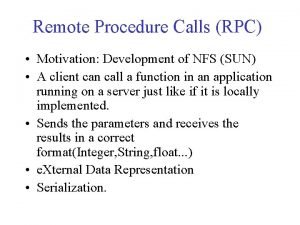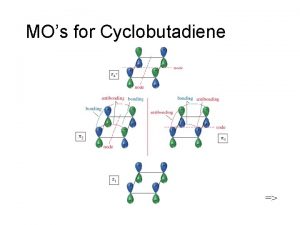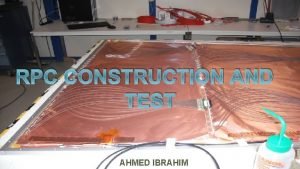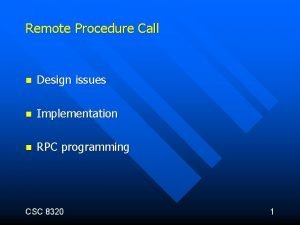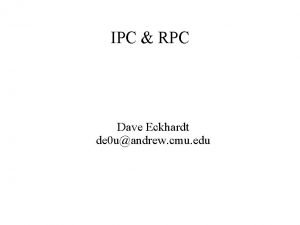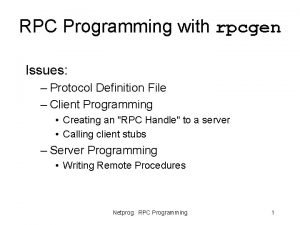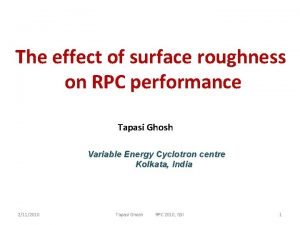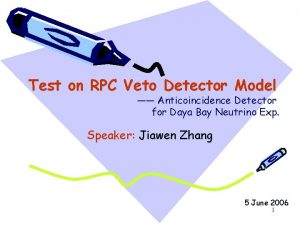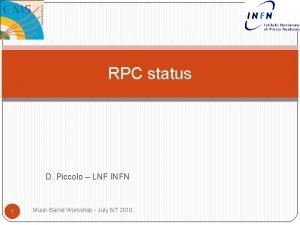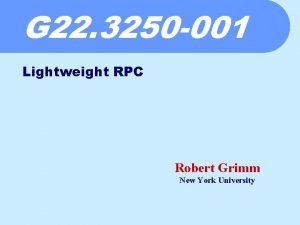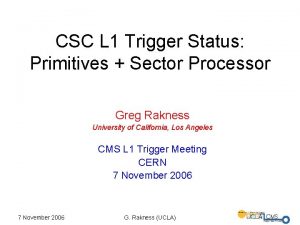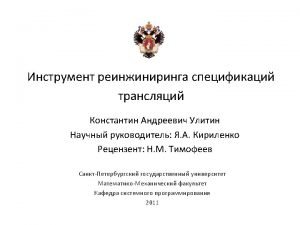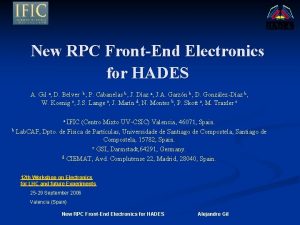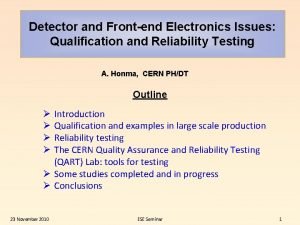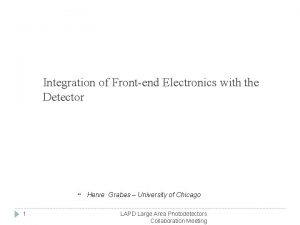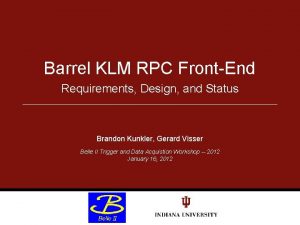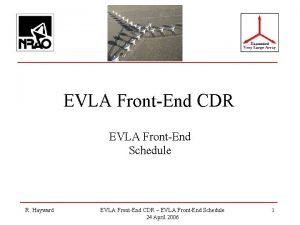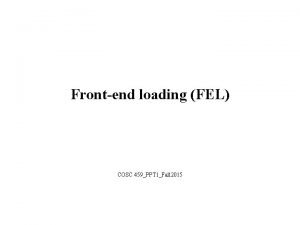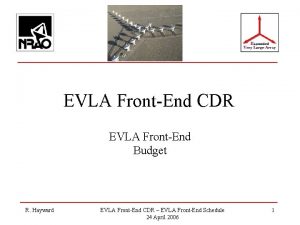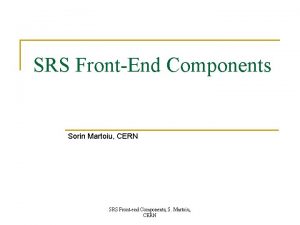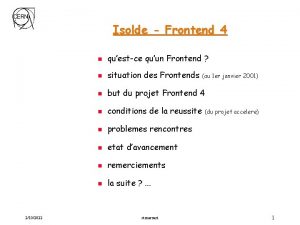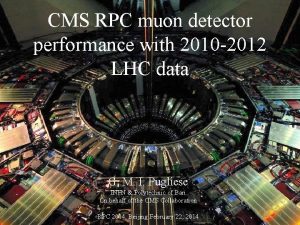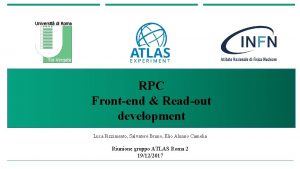RPC performance v s FrontEnd electronics and detector






































- Slides: 38

RPC performance v. s. Front-End electronics and detector parameters R. Cardarelli Infn Tor-Vergata (Italy) XIV RPC workshop, Puerto Vallarta (Messico)

Performance optimization of the RPC • To optimize the RPC performance four elements should be considered 1. 2. 3. 4. The working mode: Qtot (rate capability and aging) The pick-up geometry: d/D (maximize Qp/Qtot ), spatial resolution and crosstalk The Front-End performance: AFE , BW and noise (rate capability spatial resolution) The Gap: Thickness, multi gap (Time resolution and rate capability )

Total charge v. s. working mode of RPC • Working mode of RPC: • Streamer • Saturated avalanche • Low saturated avalanche Total charge: 1 -0. 1 n. C 20 -40 p. C 1 -5 p. C

Pick-up charge (Qp) to ionic charge (Qion) ratio Qp/Q ion= d/D D= is the distance of pick-up electrode d = average drift distance of the electrons Streamer sreamer Saturate avalanche Low saturate avalanche d D Highly saturated avalanche d d Low saturated avalanche Electrons average drift distance Average ionic drift distance

Qion/Qp ratio for RPCs with different gap

Amplitude of electronic signal vs ionic signal in the pick-up electrode vd, el = average drift velocity of electrons Tel = d / vd, el vd, ion= average drift velocity of ions Tion= G / vd, ion (Vd, el/Vd, ion)=(mel/mion) G d Qel=Qion Tion >>>Tel Iel = Qel / Tel Vel = Iel x Zl Iion = Qion /Tion Vion = Iion x Zl Voltage amplitude of the electronic signal (Vel)>>> Vion

Pick–up and ionic signal for different gap(2 -1 -0. 5 mm) Pick up ns us Graphite electrode

Ionic charge/Pick-up charge v. s. Working mode of RPC • Working mode of RPC: • Streamer • saturated avalanche • Low saturated avalanche Qion/Qp: 2 -5 10 -20 20 -30

Pick-up and ionic charge v. s. electric field for different gap(2 -1 -0. 5 mm)

Pick-up signal duration time v. s. Electric Field for RPCs with different gap

Gas amplification in different working mode Gap (1 -2 mm) N 0 = primary ionization electrons Agas = gas amplification = (Qtot / N 0 )/ e-

Moving the amplification from the gas to the Front End electronics AFE (Amplification of the Front End electronics) AFE X Agas = k where k is the discriminator threshold AFE streamer – We assume it is 1 for streamers

Working point v. s. F. E. electronic amplification at constant threshold (see Pizzimento talk)

Total charge of the working point v. s. high voltage for different front-end electronic amplification for a 2 mm gap F. E. Amplification = K F. E. Amplification = 10 k

Pick-up charge for different working modes

Signal/Noise front-end electronic requirements •

Front End electronics Bandwidth for different working mode The front-end electronic requires an open-loop Bandwidth >> 3/Tel Streamer gap (2 mm) BW>> 30 MHz gap (1 mm) BW>> 60 MHz Avalanche gap (2 mm) BW>> 300 MHz gap (1 mm) BW>> 600 MHz

Pick-up electrode optimization (see Alunno Camelia poster) Cluster. Size vs Graphite Resistivity (ρ) 0, 018 Clustere. Size Induced Signal 0, 016 Crosstalk signal 0, 014 9 8 7 0, 012 6 0, 01 5 0, 008 4 0, 006 3 0, 004 2 0, 002 1 0 -0, 002 0 2 Ground. Wire 4 No. Ground. Wire Strip 6 8 Floating Adapted 10 0 0 50 100 150 200 250 300 350 KΩ /sq

Rate capability v. s. thickness of the RPC electrode • If I have a constant ionizing particles flux (ϴ) in the surface of the RPC, the voltage drop on the resistive electrode is: V= I x R =(Qtot x ϴ) x (ρ x d/S) S=surface of the RPC and d= thickeness • If the total charge (Qtot) of the avalance is constant, the rate capability is proportional to 1/d d=thickness of the electrode • Qtot(d)? • What is the minimum thickness (d) of the electrode?

Time resolution v. s. Gap thickness • The time resolution in the RPC (tests observation) is a linear function of the gap thickness fig 1. The gas, the resistivity and the electrical field have not a large impact in the resolution. • the mathematical model is still an open point in RPC. σ (ns) 1 0. 5 (mm) 2 1 Fig 1 time resolution v. s. gap thickness

Intrinsic spatial resolution

The limit of resistivity of the electrode material l (see Alessandro Rocchi) l d d d Waveforms

Total charge for synchronous ionization particle


The block diagram of the preamplifier For RPC tests we suggest CAEN A 1426 amplifier The same scheme can be used for both Silicon and Si. Ge technology for a comparison. Silicon technology Si. Ge technology R. Cardarelli - 22/11/2013 - Roma 25

Block diagram of a new full custom front-end chip See Salvatore Bruno and Luca Pizzimento talk vco Sinc in counter IN 1 Discr. Latch IN 8 Discr. Latch I/O CK Digital out Analog out Serial out (10 Gbit/sec)

conclusions • For the optimization of the RPC detector • Rate capability: Total charge, electrode thickness and resistivity • Spatial resolution: optimization pick-up pitch (centroid of charge) • Electronic: BW>>600 MHz, amplification>200 and noise < 1000 e- RMS • Time resolution: thickness of the gap and multi-gap

BJT Si v. s. Si. Ge • B JT performances • β=τc/τt • ft=1/τt • N= K*τt E τc= base life time τt = base transient time τt (Si) >> τt (Si. Ge) BJT Si diffusion Fermi energy B C HBT Si. Ge acceleration Fermi energy B E C

Strategy for the new front-end (Si. Ge) Amp (a. u. ) Working strategy Actual result for the RPC signal Time (nsec) R. Cardarelli - 22/11/2013 - Roma 29

Signal and noise from Si. Ge Amplifier and Silicon Amplifier Pulses recorded from a 500 micron diamond sensor irradiated by 241 Am source. Silicon amplifier Si. Ge amplifier

Si. Ge amplifier application on Resistive Plate Chamber detector A 1 mm gap RPC detector read out with a ATLAS like threshold (black), the new preamplifier in silicon technology (blue) and in Si. Ge technology (red) Using a more sensitive front end allows to operate the detector at a lower gain. Data from a cosmic ray test. Total delivered charge per count in the detector. The working point with different front ends is reported. Data from a cosmic ray test. Lower gain means lower charge per count. NOTE: the total charge reported is not the prompt charge collected in the front end. ATLAS like threshold Silicon new preamplifier Si. Ge new preamplifier R. Cardarelli - 22/11/2013 - Roma 31

Jet test Acquisition 100 m coaxial cable RG 6 Diamond sensor Preamplifier Pipe of Jet 400 °C R. Cardarelli - 22/11/2013 - Roma 32

Measurements and Results PHS for the n+6 Li a +T reaction measured at JET using the MSCA located 100 m away from the SCD+6 Li. F detector. Peak-1: A 1=52 m. V Peak-2: A 2=36 m. V Peak-1: CHN=88 Peak-2: CHN=121 P 2/P 1=1. 40 A 2/A 1=1. 44 R. Cardarelli - 22/11/2013 - Roma 33

Results in Counting Mode (C-27) Time dependent neutron emission for JET pulse # 79613, #79630 and #79640 measured with both MSCA operating in counting mode and compared to F. C. R. Cardarelli - 22/11/2013 - Roma 34

Si. Ge requirements for the full custom chip • Sinusoidal signal. Pulse signal. As low as possible. R. Cardarelli - 22/11/2013 - Roma 35

Block diagram and performance of a new full custom front-end chip vco Sinc in counter IN 1 Discr. Latch IN 8 Discr. Latch I/O CK Digital out Analog out Serial out (10 Gbit/sec)

Conclusions • The RPC performance is strictly connected with the gap thickness, resistivity and surface of the electrode, pick-up design and front-end electronics performance. • The Si. Ge technology has been chosen to realize a new high performance front-end for RPCs.

Electrodes thickness S d Qtot = Qion + Qel G D Qel/Qtot= d / (2 x S/εr + G)
 Front end and back end phases of compiler
Front end and back end phases of compiler Frontend user interface
Frontend user interface 100101010
100101010 Api frontend backend
Api frontend backend Flexbox vs bootstrap
Flexbox vs bootstrap Rpc and rmi in distributed system
Rpc and rmi in distributed system Rmi/rpc
Rmi/rpc Asynchronous rpc
Asynchronous rpc Rpc message format
Rpc message format Rpc plumbing
Rpc plumbing Rpc semantics in the presence of failures
Rpc semantics in the presence of failures Communication protocols for rpc
Communication protocols for rpc Rpc woerden
Rpc woerden Statutory rape rpc
Statutory rape rpc Remote procedure call diagram
Remote procedure call diagram Beton proporcje
Beton proporcje _vti_cnf exploit
_vti_cnf exploit Transaction processing system architecture
Transaction processing system architecture Avalanche rpc
Avalanche rpc What is the primary motivation for development of rpc
What is the primary motivation for development of rpc Openchain rpc
Openchain rpc Rpc implementation in distributed system
Rpc implementation in distributed system Ad / sysvol version mismatch,enforced
Ad / sysvol version mismatch,enforced Rpc construction
Rpc construction Design issues of remote procedure call
Design issues of remote procedure call Rpc vs ipc
Rpc vs ipc Clnt_create: rpc: unable to receive
Clnt_create: rpc: unable to receive Rpc
Rpc What is rpcgen
What is rpcgen Polygonscan
Polygonscan Rpc
Rpc Rpc
Rpc Rpc roughness
Rpc roughness Rpc 2 u
Rpc 2 u Rpc status: -532462766 -532462766
Rpc status: -532462766 -532462766 Lightweight rpc
Lightweight rpc Rmi rpc
Rmi rpc Ucla rpc
Ucla rpc Champaign county regional planning commission
Champaign county regional planning commission

